Best Years for Gibson Les Paul – Years to Avoid

Best years to buy a Gibson Les Paul, and years to avoid considering Gibson good wood era and bad wood years as the Norlin Era.
Gibson Les Paul: good and bad wood years
The Gibson Les Paul is a legendary guitar that has left an indelible mark on the world of music. Over its long and storied history, the Les Paul has seen periods of exceptional quality and innovation, as well as times when it faced challenges. If you’re a guitarist or a collector considering investing in a Gibson Les Paul, it’s essential to understand the best years for quality and those to avoid.
In this article, we’ll take you on a journey through the history of the Gibson Les Paul, highlighting its golden ages and dark periods. By the end of this article, you’ll have a clear understanding of which eras offer the best value for money and which to approach with caution.
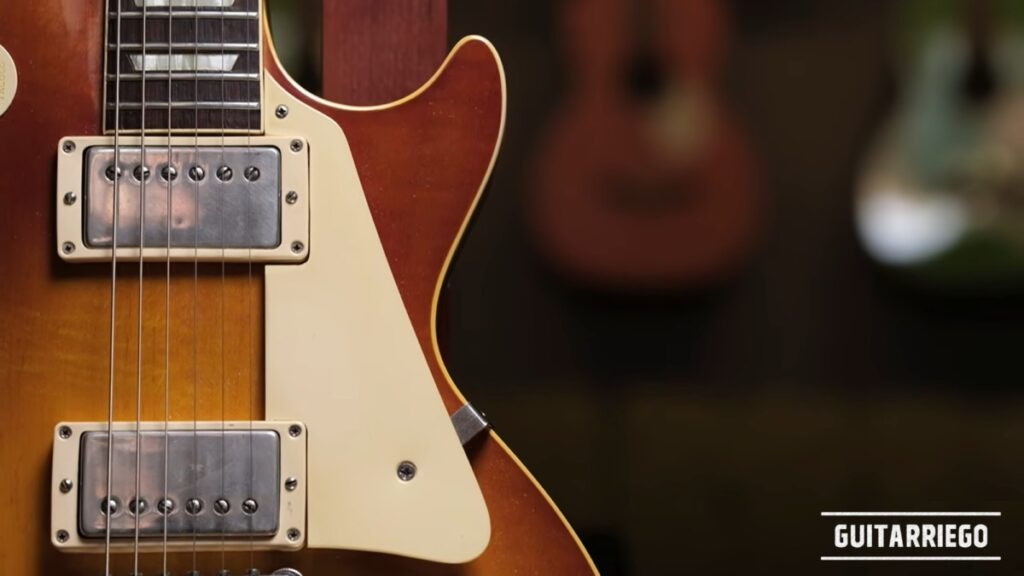
You might also be interested in the story of Orville Gibson, the founder of the Gibson Corporation.
The Beginnings of the Les Paul – 1952-1957
The Gibson Les Paul made its debut in 1952 as the Gibson Goldtop. This marked the genesis of a guitar that would go on to become one of the most iconic instruments in music history. The early years of the Les Paul were a period of experimentation and innovation.
Under the leadership of Ted McCarty, Gibson aimed to rival the Fender Broadcaster, a solid-body electric guitar gaining popularity at the time. The result was the birth of the Gibson Goldtop, the first solid-body electric guitar from Gibson.

You might be interested in reading about the history of the rivalry between Gibson and Fender.
Specifications and evoluation of the first Gibson Les Paul
These early Les Paul models featured P90 pickups, often affectionately referred to as “soap bar” pickups due to their distinctive appearance. P90s offered a versatile sound profile that appealed to a wide range of musicians, from blues to rock and country players.
One notable feature of the early Les Pauls was the trapeze tailpiece. This design, more commonly associated with hollow-body guitars, was a unique choice for a solid-body electric. It enhanced the guitar’s natural resonance, although it would undergo changes in subsequent years.
Wraparound Bridge and Tune-O-Matic
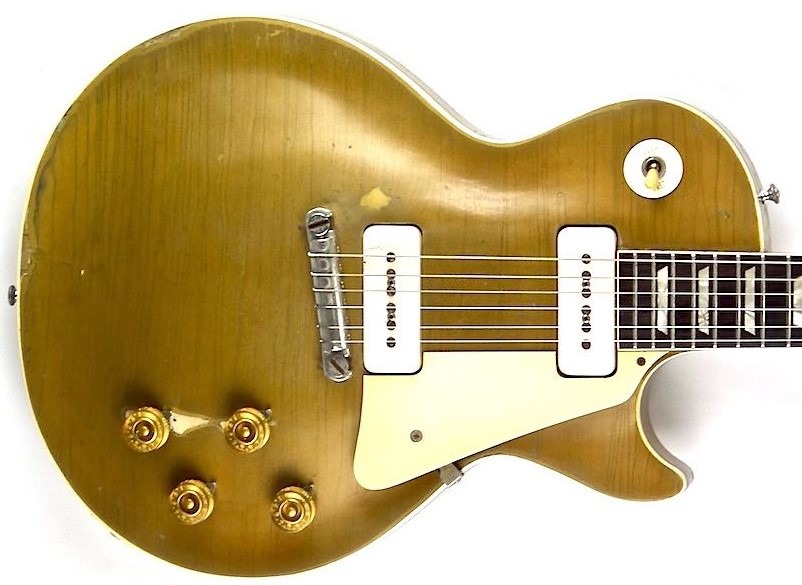
In 1953, Ted McCarty introduced a significant improvement to the Les Paul’s design: the solid wraparound tailpiece and bridge. This change aimed to enhance playability and overall tonal quality. This transition marked a pivotal moment in the evolution of the Les Paul.
Further innovations followed, and in 1955, Gibson introduced the Tune-O-Matic bridge. This bridge design greatly improved intonation and became a hallmark of the Les Paul’s sound and playability.
The early Les Pauls were built with meticulous attention to detail. They featured a mahogany body and neck, an arched maple top, and a rosewood fingerboard. The neck was securely glued to the body and adorned with the classic mother-of-pearl trapezoid-shaped inlays.
During these formative years, the Les Paul was on a journey of discovery, with each modification and innovation contributing to the guitar’s eventual status as an iconic instrument. While production of the original Les Paul halted in 1960, its legacy continued to thrive, and Les Pauls from this era remain highly sought after for their historical significance and exceptional craftsmanship.
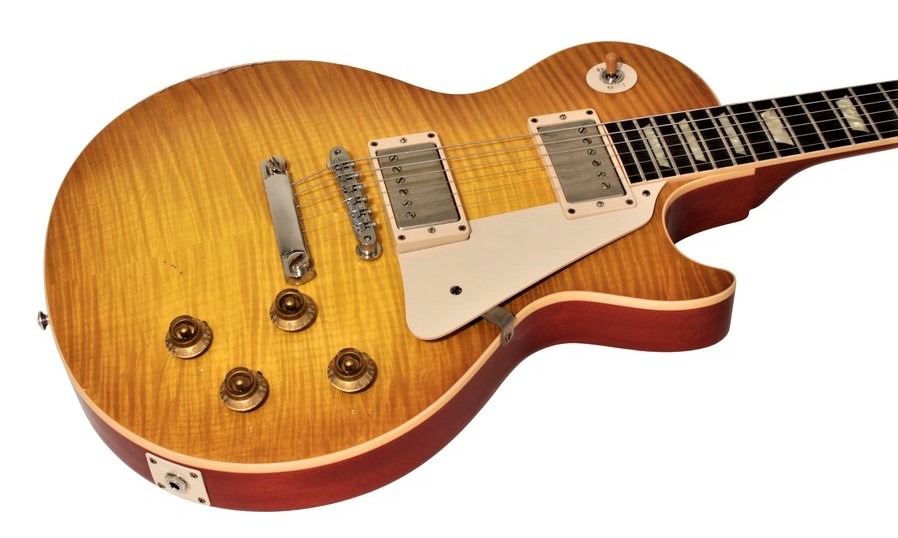
We recommend that you read this note if you want to know more about Ted McCarty’s management at Gibson.
Great wood and craftsmanship era for Gibson Les Paul
The evolution of the Gibson Les Paul is a testament to the dedication and innovation of its creators. From its early years as a groundbreaking solid-body electric guitar to the refinement of its design and materials, the Les Paul has left an indelible mark on the world of music.
The Golden Age of the Les Paul – 1957-1960
In the annals of electric guitar history, there exists a period that is heralded with reverence and awe—the Golden Age of the Gibson Les Paul, spanning from 1957 to 1960. These years are etched in the minds and hearts of guitar enthusiasts as the pinnacle of craftsmanship, where high-quality materials and unparalleled artistry converged to create instruments of legendary status. Definitely, the best years for the Gibson Les Paul are 1957, 1958, 1959 and 1960.
The evolution of Gibson sound: PAF pickups

One of the most pivotal transformations during this era was the adoption of PAF (Patent Applied For) pickups. These humbucker pickups, often hailed as some of the finest ever fitted to any guitar, ushered in a new era of tonal possibilities for the Gibson Les Paul. Renowned for their warm, fat tone while retaining the resonant treble characteristics of the earlier P90s, PAF humbucker pickups quickly ascended to legendary status. Their introduction to the Gibson Les Paul lineup added an unmistakable sonic richness that set these instruments apart.
Visit our guide on how to adjust the PAF Humbucker pickups on your Gibson Les Paul.
Distinguishing the ‘Burst Years: A Nuanced Appreciation

While each year of the Golden Age is a treasure in its own right, subtle distinctions set them apart. In 1957, the Les Paul still retained the Goldtop finish. It wasn’t until 1958 that the iconic Sunburst finish made its debut, showcasing plain or figured maple tops. Guitars crafted between 1958 and 1960, affectionately known as “Bursts,” occupy a special place in the hearts of collectors and players. Among these Burst models, 1959 stands out, primarily due to the consistent presence of flamed tops, known for their exceptional quality.
Consequently, the hierarchy of value within the Golden Age often unfolds as follows: first, the revered Les Pauls from 1959, followed by those from 1960, 1958, and the ’57 Goldtop. Another noteworthy distinction lies in the “slim-taper neck” profile introduced with the 1960 models.
The Birth of a Legend: The Les Paul Standard ’59
Within this Golden Age, the years 1958, 1959, and 1960 stand as the “Burst” years, a term of reverence among guitar aficionados because of the Sunburst finish. However, if one were to seek the definitive zenith of the Gibson Les Paul, it would invariably point to the year 1959. The Les Paul Standard ’59, produced during this time, is widely regarded as the greatest guitar ever crafted by Gibson. Clearly, if we have to choose one, the best year for the Gibson Les Paul is 1959.
These ’59 models, resplendent in their tonal prowess and craftsmanship, became the darlings of guitar legends such as Jimmy Page, Eric Clapton, and Keith Richards. Their popularity continued to surge throughout the 1960s, despite Gibson temporarily ceasing Les Paul production in 1960.

If you want to know more about this, read the evolution of the Gibson Les Paul.
The Rarity and Legacy of Gibson Les Paul
These Golden Age Les Pauls, ranging from 1957 to 1960, are unequivocally the pinnacle of Gibson’s artistry. However, the shortage of instruments in these years, due to the limited production, totally handmade and its exceptional quality, makes its prices very high, in many cases exceeding USD 100,000 for a guitar.
Discontinuation of the Gibson Les Paul
In 1960, Gibson made the difficult decision to discontinue the Les Paul, introducing the SG as its replacement due to declining sales. This marked the end of an era, but the legacy of the Golden Age Les Pauls endures, as their timeless craftsmanship and unparalleled tone continue to captivate musicians and enthusiasts worldwide.
You may be interested in this note on the best guitarists who played Gibson guitars.
The Return of the Les Paul – 1968-1971
After its initial glory days, the Les Paul faced a period of dormancy. Yet, thanks to the unwavering demand driven by the instrument’s adoption by numerous legendary guitarists, Gibson brought the Les Paul out of its early retirement in a revival that spanned from 1968 to the present day.
Resurrection and Evolution of Gibson Les Paul

The revival of the Les Paul in 1968 marked a significant moment in the instrument’s history. Gibson responded to the clamor of the music world with the reintroduction of two distinct models, each carrying its own unique charm.
The first model to hit the scene was the Goldtop Les Paul, a nod to its 1956 predecessor. Sporting the classic single-coil P90 pickups.
The second model to grace the stage was the Les Paul Custom, reminiscent of the iconic Customs of the 1950s. However, there was a notable departure from tradition—the addition of a maple top. This deviation from the classic all-mahogany body configuration introduced a new dimension to the Les Paul Custom’s sound, offering players a tonal palette that blended the best of both worlds.
The appearance of the Mini-Humbucker
In 1969 it was the appearance of the Les Paul Deluxe with mini-humbucker pickups. While the core design remained similar to the 1968 models, the P90 pickups were swapped out for mini-humbuckers. These pickups and their frame occupied the same space as the P90 pickups. This change was not driven by a tonal shift but by practicality, utilizing existing mini-humbucker stock from the Epiphone factory. Despite this practicality, the mini-humbuckers found favor among players for their unique voice, bridging the sonic gap between the single-coil P90s and the humbucking PAFs.
We recommend that you read the history of Epiphone guitars: secrets, myths and truths of a great guitar manufacturer.
The Third Most Sought-After Era of the Les Paul
This period, spanning from 1968 to mid-1971, constitutes a distinct chapter in the Les Paul’s history. It’s a chapter that is cherished by collectors and players alike, making it the third most sought-after era for the Gibson Les Paul. The revival models of this era, while paying homage to their illustrious predecessors, introduced innovations that breathed new life into the Les Paul legacy.
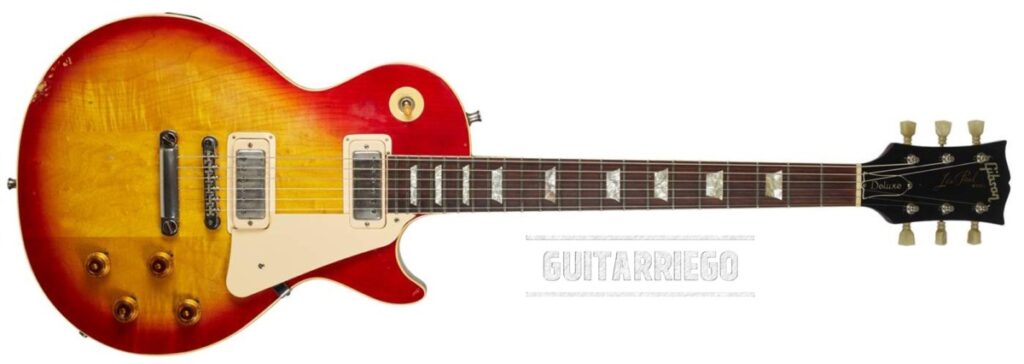
You may be interested in the technique of Black Light or ultraviolet to examine vintage guitars.
The Norlin Era – 1970-1985
A Controversial Chapter in Gibson’s History
The period from 1970 to 1985 marks a significant chapter in the history of Gibson, often referred to as the “Norlin Era.” During this time, Gibson underwent substantial changes due to shifts in ownership, an evolving industrial landscape, and competition from high-quality Japanese guitars. This era is characterized by a mix of controversy, innovation, and adaptations, all of which left a lasting impact on the iconic Les Paul guitar.

Ownership Transitions and Corporate Decisions
In 1969, Gibson’s parent company, Chicago Musical Instruments (CMI), was acquired by a South American conglomerate called ECL. Subsequently, in 1974, Gibson became a subsidiary of Norlin Musical Instruments, thus commencing the Norlin Era.
To some, this period represents the “dark years” of Gibson, primarily due to corporate cost-cutting measures and perceived declines in product quality. However, upon closer examination, it becomes evident that not all changes were detrimental. Some, in fact, have stood the test of time. For purists, years to avoid for the Gibson Les Paul are from 1970 to 1985 because of Gibson bad wood years and changes in the manufacturing approach.
In the history of the company, not all were success stories, there were also great Gibson failures, rare, ugly or misunderstood guitars.
Pancake Bodies: A New Construction Approach
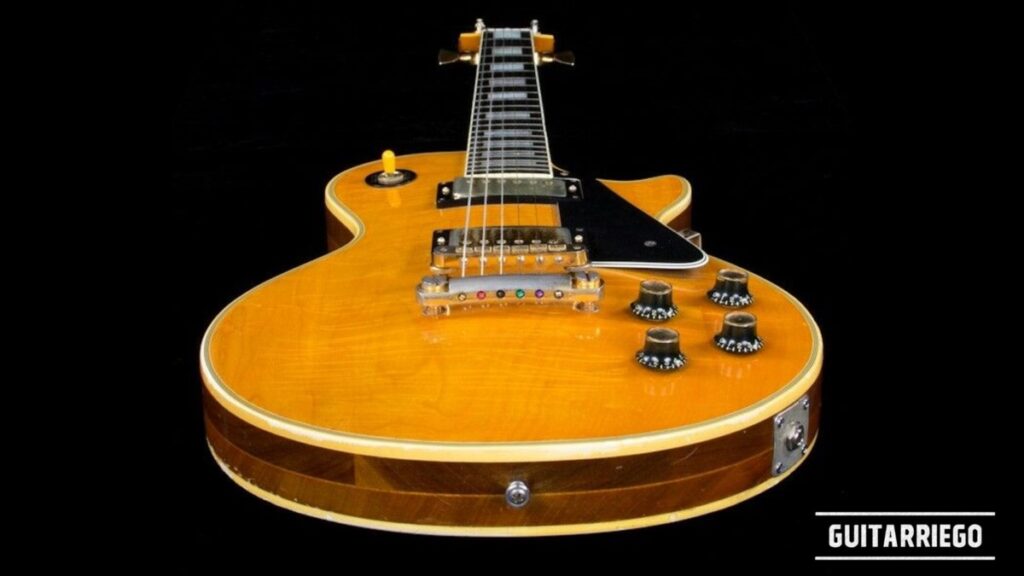
One of the most visible alterations introduced during the Norlin Era was the adoption of “pancake” bodies for Les Paul guitars. This construction method consisted of sandwiching a thin piece of maple wood between two other pieces of mahogany.
These changes aimed to enhance rigidity and stabilization of the bodies, and economize production costs. However, opinions on the tonal impact of pancake bodies and multi-piece construction remain divided. Some enthusiasts argue that they dull the guitar’s tone and diminish its cosmetic appeal.
Three-Piece Necks and the Introduction of the Volute

In a move to strengthen the Les Paul design, Norlin introduced a feature known as the volute. This addition was intended to prevent headstock breakages, a common issue when the headstock angles away from the neck. The volute has since become a standard practice on guitars with angled headstocks, offering the advantage of increased durability without significant drawbacks.
Another noteworthy change was the shift from traditional one-piece necks to three-piece necks. Historically, Gibson had used a single piece of mahogany for Les Paul necks, but during the Norlin Era, three-piece necks became the norm. Gibson also made three-piece maple necks, because of the greater strength of maple over mahogany. While some purists initially resisted this change, it was introduced partly to reduce the consumption of mahogany timber and lower production costs. Surprisingly, three-piece maple necks have proven to be more stable over time, defying initial skepticism.
The heaviest Gibson Les Paul guitars
Another thing to note about the Norlin Era Gibson Les Pauls was their excessive weight. The Gibson Les Paul manufactured in these years can exceed 12 pounds -5.44 kg-.
Perhaps you are interested in knowing about the weight of each electric guitar model.
9-hole weight relief
In 1982, Gibson implemented the traditional 9-holes weight relief. Which consists of making 9 circular holes on the mahogany body that are then covered by the maple top. In this way they partially corrected the problem of the excessive weight of Gibson Les Paul guitars.
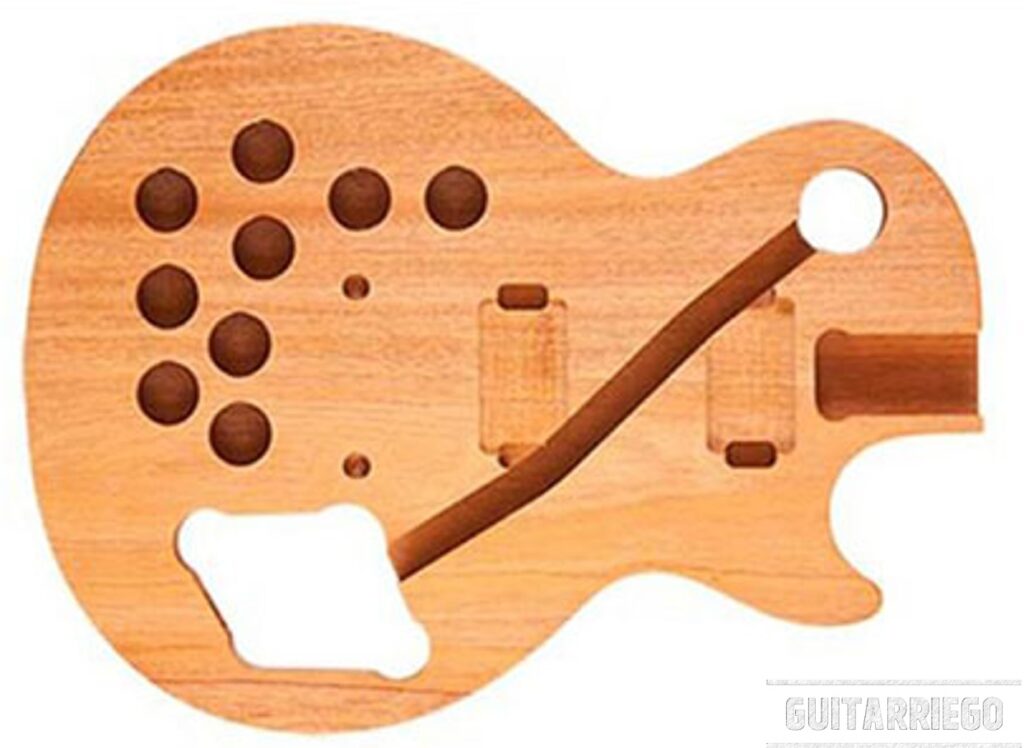
A Controversial Legacy
The Norlin Era is undoubtedly a controversial chapter in the Les Paul’s history. While it’s marked by alterations that ruffled the feathers of purists, some changes, like the volute and three-piece maple and mahogany necks, have withstood the test of time. These innovations, whether born out of necessity or cost-saving measures, contributed to the Les Paul’s resilience and adaptability.
In retrospect, the Norlin Era underscores the complexity of maintaining tradition while adapting to a changing industrial landscape and aggressive competition from Japanese manufacturers.
You might also be interested in the history and myths of a classic Gibson color, TV Yellow.
The Post-Norlin Era – 1986-2007
Rekindling the True Essence of the Gibson Les Paul
The period from 1986 to 2007 marked a significant turning point in the history of Gibson and its iconic Les Paul guitars. After facing financial challenges in the wake of the Norlin Era, the company experienced a remarkable resurgence under the leadership of Henry E. Juszkiewicz, David H. Berryman, and Gary A. Zebrowski, three investors who acquired the struggling brand in 1986.

A Return to Quality and Tradition of the Les Paul
Gibson, once on the brink of bankruptcy, underwent a remarkable transformation during this era. One of the pivotal changes involved a recommitment to quality. The company implemented rigorous quality control measures across all production processes, ensuring that only the finest materials and meticulous finishes were used.
In the late 1980s, Gibson embarked on a journey to redefine its models based on classic specifications. This marked the beginning of a return to what many fans of the brand considered the “correct” way to craft traditional Les Paul guitars. It was a conscious effort to recapture the essence of the Les Paul’s storied history.
To achieve these quality improvements, Gibson restructured itself, reducing its size and adopting a more manageable approach to manufacturing. This shift allowed for greater control over production processes and, in turn, the products themselves.
The results of these efforts were palpable. From the mid-1980s onwards, a significant revitalization of the brand began to take shape. Some exemplary models emerged during this period, with the 1990s often regarded as a modern golden age for Gibson.
Also, you might be interested in our post about the differences between a Gibson Les Paul and an Epiphone Les Paul.
Stability and Consistency in Quality (2000-2006)
As the new millennium dawned, Gibson continued its trajectory of improvement and consistency. During this period, there were no significant departures from the path of quality and traditional craftsmanship. The lessons learned from the tumultuous Norlin Era were firmly ingrained in the company’s ethos.

Gibson Les Paul models were now in line with market expectations and the high standards enthusiasts had come to associate with the brand. The company’s production continued to expand, driven by a commitment to quality that resonated with both long-time aficionados and new generations of guitarists.
One of the most significant shifts was the return to using high-quality woods, reverting to the roots of Gibson’s craftsmanship. Layering techniques, which had been employed as cost-saving measures, were abandoned in favor of a more traditional approach to wood selection and construction. Additionally, the three-piece mahogany or maple necks were replaced with one-piece mahogany necks, reflecting a dedication to authentic Les Paul design. These are considered Gibson modern good wood years.
A Legacy of Restoration and Renewal
The Post-Norlin Era is marked by Gibson’s remarkable journey from the brink of financial collapse to a resurgence characterized by enhanced quality and a return to its traditional roots. Under new ownership and visionary leadership, Gibson Les Paul guitars once again became symbols of craftsmanship and musical excellence.
The commitment to using superior materials, precise craftsmanship, and traditional construction methods ensured that the Les Paul regained its place as an iconic instrument cherished by guitarists worldwide.
Do not miss our comparison between Gibson and Fender guitars.
Decline in Quality – 2007-2012
Weathering the Storm: the Gibson bad wood years
The years from 2007 to 2012 marked a challenging era for Gibson and its iconic Les Paul guitars. During this period, Gibson faced a confluence of challenges that impacted the quality and construction of its legendary instruments.
Materials Shortages
One of the most significant hurdles Gibson encountered was the shortage of crucial tonewoods, particularly rosewood and ebony. This scarcity posed a severe threat to the quality of the guitars, as these woods had long been associated with exceptional sound and craftsmanship.
The shortage of high-quality tonewoods had a direct impact on Gibson’s ability to produce instruments that met their renowned standards. This scarcity led to the introduction of alternative construction methods in an attempt to adapt to changing circumstances.
Chambering and Its Consequences
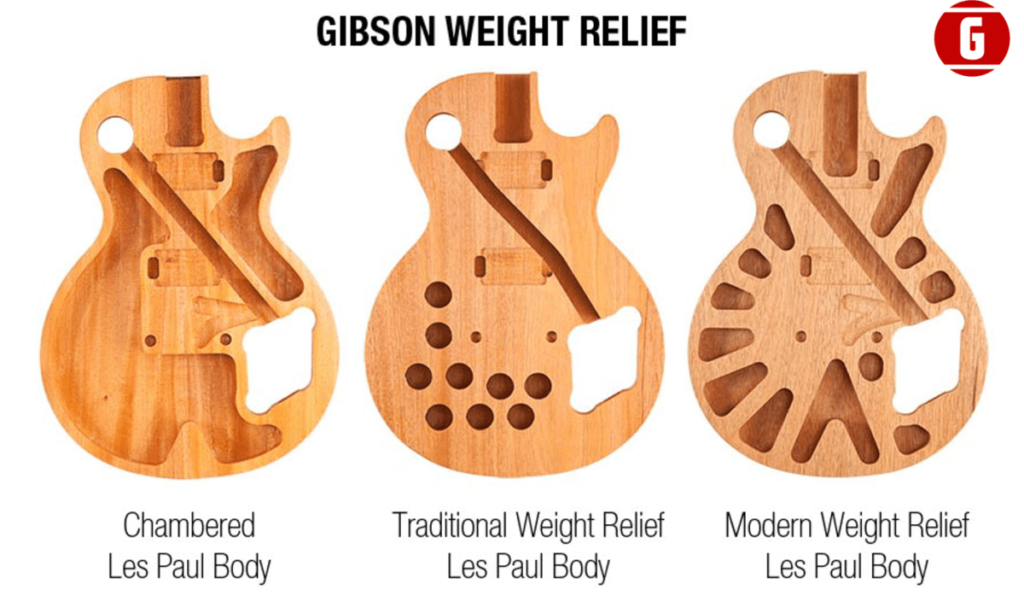
To counteract the lack of premium tonewoods and the increasing difficulty in sourcing them, Gibson implemented chambering in some of its Les Paul models during this period. Chambering involves removing sections of solid wood from various areas of the guitar body and then concealing them with the top, ultimately reducing the weight of the instrument.
While chambering was seen as a solution to maintain a reasonable guitar weight, it faced resistance from purists and aficionados. Critics argued that this practice deviated from the traditional Les Paul design and compromised the instrument’s iconic tonal characteristics. Furthermore, concerns arose about the structural integrity of the guitars, as the use of hollowed-out bodies was perceived as making them more prone to breakages.
We recommend this note if you want to know more about Gibson Les Paul weight reduction.
The Emergence of Laminates
From 2012 onward, Gibson found itself grappling with the ongoing issue of sourcing high-quality tonewoods. To address this challenge, Gibson made the controversial decision to implement the use of laminates and return to multi-piece layered construction techniques for some models.
Transition to Richlite
The shortage of ebony, a crucial component in the Gibson Les Paul Custom model, led to another significant change in 2010. The iconic Gibson Les Paul Custom, known for its ebony fingerboard, transitioned to using Richlite as a substitute. Richlite is a synthetic material composed of cellulose and phenolic resin, engineered to replicate the qualities of ebony.

Gibson bad wood years
The period from 2007 to 2012 was undoubtedly a challenging time for Gibson and its Les Paul guitars. The convergence of woods shortages, alternative construction methods, and the use of synthetic materials marked a departure from the traditional craftsmanship and quality that had defined the Les Paul for generations. Therefore, the years from 2007 to 2012 are characterized by the use of woods of dubious quality, if not poor or bad, in the construction of the Gibson Les Paul.
Perhaps you might be interested in what alternative woods to mahogany are used for cheap guitars such as Les Paul.
Modern-day Resurgence – 2013-Today
Gibson Quality Revival
The period from 2013 onwards represents a pivotal chapter in the Les Paul’s storied history, marked by a resurgence in quality and craftsmanship. This era heralded a solution to the sourcing problems that had plagued Gibson, ensuring a consistent supply of mahogany, a key tonewood, for building high-quality Les Pauls.
One of the key strategies employed during this revival was the implementation of a tiered approach to wood selection. Different grades of wood were designated for various models, with the finest and most resonant woods reserved for the top-tier Les Pauls. This approach ensured that even the more affordable models maintained a high standard of construction and sound.
A Modern Twist of the Les Paul
In 2014 and 2015, Gibson made attempts to modernize the Les Paul brand, introducing innovations like the G-Force robot tuners, Zero Fret Nut, high-performance neck joints, and unconventional logos and inlays. However, these changes were met with resistance from purists and traditionalists who cherished the timeless elements of the Les Paul’s design.

You may be interested in our opinion on the Gibson LPJ 2014.
Return to Gibson Les Paul Tradition
The turning point came in 2016 when Gibson shifted its focus back towards tradition and the classic specifications that had made the Les Paul legendary in the first place. This transition was accompanied by an emphasis on Historic models for the higher-end lines, catering to those who sought the authentic Les Paul experience.
Overcoming Challenges for Gibson
During this time, Gibson also undertook significant restructuring to align its workforce with changing guitar buying trends. The goal was to optimize production and achieve cost savings without compromising quality. This strategy allowed Gibson to continue using high-quality materials and woods, reinforcing its commitment to craftsmanship.
However, Gibson faced financial turbulence, filing for bankruptcy in May 2018. Remarkably, the company swiftly rebounded, regaining its financial footing by November of the same year. This resilience showcased the enduring appeal of the Les Paul and the dedication of its fanbase.
Modern Les Pauls: A Legacy Continues
Today, Les Pauls are manufactured to a standard that rivals the legendary models produced in the late 1950s. The return to traditional craftsmanship, combined with a wider range of models to cater to diverse customer preferences, has propelled the Les Paul brand to new heights. Fans of the Gibson Les Paul now enjoy an impressive array of price and quality options.
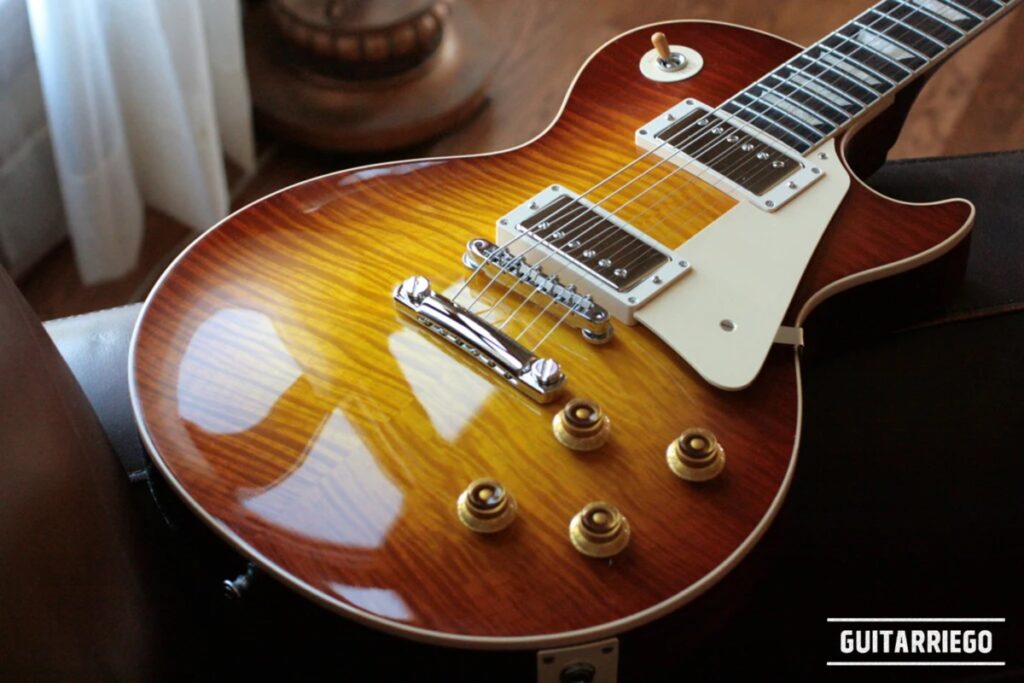
We recommend that you visit this note on the rarest and most sought after guitars in the world.
Summarizing the Best and Worst Years for Gibson Les Paul
In summary, if you’re looking for the best value for money, the golden age of the Gibson Les Paul from 1957 to 1960, especially the 1959 ‘Burst’ guitars, is highly regarded. These guitars are often considered the finest ever made. Additionally, Les Pauls from 2016 onwards are known for their high quality and craftsmanship.
On the other hand, it’s advisable to approach the Norlin era (1970-1985) with caution due to the mixed reception of certain design changes. The period from 2007 to 2015 is also a time when quality concerns arose, primarily because of wood-sourcing challenges and alternative construction methods.
Ultimately, the choice of the best Les Paul year depends on your personal preferences, budget, and whether you prioritize vintage collectible guitars or the playability of modern models. Each era has its unique charm and character, making the Gibson Les Paul a timeless and iconic instrument.
So, what’s your favorite time for value for money? Share your Les Paul experiences in the comments section below and keep the music alive with this legendary guitar.
Source: Best Years for Gibson Les Paul and Worst Years to Avoid – Guitar Quarter.






